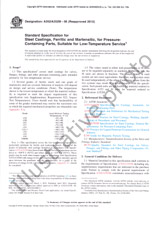We need your consent to use the individual data so that you can see information about your interests, among other things. Click "OK" to give your consent.
ASTM D8409-21
Standard Guide for Conducting Stacking Tests on UN Packagings Using Guided or Unguided Loads
Translate name
STANDARD published on 15.10.2021
The information about the standard:
Designation standards: ASTM D8409-21
Publication date standards: 15.10.2021
SKU: NS-1045137
The number of pages: 8
Approximate weight : 24 g (0.05 lbs)
Country: American technical standard
Category: Technical standards ASTM
Annotation of standard text ASTM D8409-21 :
Keywords:
49 CFR, dangerous goods, design qualification, dynamic compression test, guided load, hazardous materials, periodic retest, stack, stacking, unguided load,
Additional information
| Significance and Use |
|
4.1?This guide is intended to provide a standardized method and a set of basic instructions for performing stack testing on UN packaging designs using either guided or unguided top loads. This guide provides the suggested minimum information that should be documented when conducting stacking test and provides information for recommended equipment. 4.2?All packaging design types other than bags must be subjected to a stacking test. Packagings subject to the stacking test must be capable of withstanding a superimposed top load of a specified minimum mass for a specified period of time without failure as these parameters are defined in the regulations. The test is not intended to determine the absolute top load capability of a packaging. Note 1:?When quantification of box compression strength is
desired for determining stacking strength or for design purposes
use Test Method D642 and
conditioning as recommended in 4.5.
4.3?Design qualification testing procedures are intended, as explicitly stated in the HMR, to be the minimum performance capability levels for packaging manufactured to transport Hazardous Materials under conditions normally incident to transportation. 4.4?The HMR tests are designed to be gross package capability evaluations that can be performed in a similar manner in all parts of the world, but under circumstances with some variance in test facility capabilities. This is an intentional feature of the test designs and protocols. The focus of HMR testing is not the determination of quantifiable, comparison data to allow for analytical evaluation. 4.5?It is recommended that facilities performing the HMR tests consult the guidance on conditioning in the relevant ASTM documents for any particular packaging material as applicable. The following conditioning documents, Practices D4332 and D685, are commonly used. |
| 1. Scope |
|
1.1?This guide is intended to provide a standardized method and a set of basic instructions for conducting stacking tests on United Nations (UN) non-bulk, intermediate bulk container (IBC), and Large Packagings. Using guided or unguided loads in accordance with the U.S. Department of Transportation Title 49 Code of Federal Regulations (CFR) and the UN Recommendations on the Transport of Dangerous Goods (The Orange Book). The combination or interchange of these regulations will be referred to as the Hazardous Material Regulations (HMR). 1.2?The Dangerous Goods Regulations require performance tests to be conducted on packaging designs prior to being authorized for use. The regulations do not include standardized procedures to accomplish this which can result in differences between testing facilities. The purpose of this document is to provide guidance and to establish a set of common practices for conducting stack testing on packagings undergoing UN certification. 1.3?The user of this guide must be trained in accordance with 49 CFR as required by 172.700 and should be familiar with other applicable hazardous materials regulations such as; International Civil Aviation Organization (ICAO) Technical Instructions for the Safe Transport of Dangerous Goods by Air, the International Maritime Dangerous Goods Code (IMDG Code), and carrier rules such as International Air Transport Association (IATA) Dangerous Goods Regulations. 1.4?The values stated in SI units are to be regarded as standard. The values given in parentheses after SI units are provided for information only and are not considered standard. 1.5?This standard does not purport to address all of the safety concerns, if any, associated with its use. It is the responsibility of the user of this standard to establish appropriate safety, health, and environmental practices and determine the applicability of regulatory limitations prior to use. 1.6?This international standard was developed in accordance with internationally recognized principles on standardization established in the Decision on Principles for the Development of International Standards, Guides and Recommendations issued by the World Trade Organization Technical Barriers to Trade (TBT) Committee. |
We recommend:
Technical standards updating
Do you want to make sure you use only the valid technical standards?
We can offer you a solution which will provide you a monthly overview concerning the updating of standards which you use.
Would you like to know more? Look at this page.




 Cookies
Cookies
